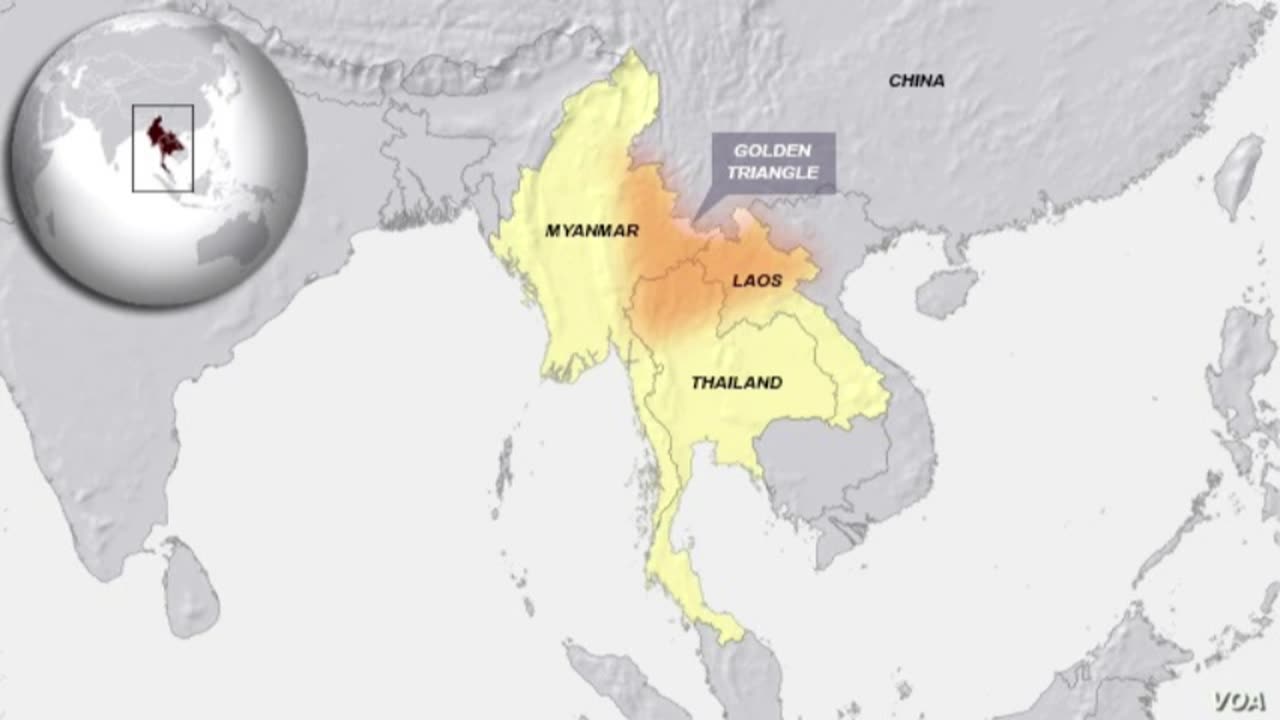Premium Only Content

Narco-Nationalism & Foreign Policy Segment 1-Myanmar
Timeline of Events:
Pre-1988:
Pre-1949: The Golden Triangle (Myanmar, Laos, Thailand) emerges as a major hub for heroin production, earning the nickname "breadbasket" of the world's heroin trade.
1949: China comes under Communist control, tightening border security and significantly curbing drug trafficking.
1972: Alfred McCoy publishes "The Politics of Heroin in Southeast Asia," highlighting the complex relationship between drug trafficking, insurgency, and international politics in the region.
1982: Yunnan Province becomes the first in China to establish specialized anti-narcotics police teams.
1988: The US suspends direct counter-narcotics aid to Myanmar following the military junta's crackdown on pro-democracy movements.
1988-2000:
1990s: Myanmar emerges as a major producer of amphetamine-type stimulants (ATS) in Asia.
1992: Chinese government deploys military to Weishan Prefecture near the Vietnam-China border to crack down on armed drug traffickers.
1994: Yang Maoxian, a drug lord controlling trafficking from the Kokang area of Myanmar, is apprehended in Yunnan Province in a landmark case.
Late 1990s: Khun Sa, a notorious drug lord known as the "King of Heroin," surrenders to Burmese authorities following pressure from joint Burmese and Wa military campaigns.
2001-2020:
2001:Tan Xiaolin, a major trafficker operating from Muse, Myanmar, is arrested and extradited to China, accused of smuggling over 3 tons of heroin.
Chinese authorities make their largest ever drug bust, seizing 672 kg of heroin concealed within lumber en route to Guangzhou.
2002: Liu Min, a trafficker linked to exporting over 510 kg of heroin to China, is killed by Kokang and Burmese authorities under pressure from the Chinese government.
2004: Tan Xiaolin is convicted and executed in China.
2005:US federal court indicts leaders of the United Wa State Army (UWSA), effectively halting indirect US counter-narcotics aid to Myanmar.
Myanmar joins the United Nations Convention against Transnational Organized Crime (UNTOC).
2006: The Asia Wealth Bank, linked to money laundering and drug trafficking, is shut down by the Myanmar military junta, with its chairman and associates arrested.
2011-2020: Southeast Asia experiences year-on-year increases in methamphetamine seizures, highlighting the region's growing drug trade.
2015-2019: East and Southeast Asia rival North America in the volume of methamphetamine seized, signaling the region's significant role in the global drug trade.
2019: The UN estimates the regional drug market in East and Southeast Asia to be worth $60 billion.
2021-Present:
February 2021: Myanmar military coup triggers economic instability and weakens state control, creating favorable conditions for drug cartels.
May 2021: Assam Police launch a campaign resulting in over Rs 1,500 crore worth of drugs being seized, primarily entering from Myanmar via Manipur and Nagaland.
Mid-2021: Thai authorities report a surge in methamphetamine seizures, including a record 55.6 million yaba pills and 1.5 tonnes of crystal meth in October, attributed to the situation in Myanmar.
2021-2022: Mexican cartels, particularly the Sinaloa Cartel and CJNG, increase their presence in the Asia-Pacific, primarily focusing on Australia and New Zealand. The Sinaloa Cartel begins distributing high-quality Mexican meth, directly engaging with New Zealand biker gangs.
2022-2023: Myanmar surpasses Afghanistan as the world's top opium producer, with a significant expansion of poppy cultivation areas, particularly in northern Shan State, Chin State, and Kachin State.
2024:DEA announces a reward for information leading to the capture of Jian Zhang, a Chinese national accused of leading a global anabolic steroid and fentanyl precursor chemical distribution ring.
US authorities charge a Chinese citizen for running a massive anabolic steroid and fentanyl precursor chemical distribution network spanning 84 countries and all 50 US states. This network allegedly used sophisticated shipping methods and disguised packaging to move its contraband.
Cast of Characters:
Drug Traffickers & Organizations:
Khun Sa: Notorious drug lord known as the "King of Heroin" who dominated the heroin trade along the Thai-Myanmar border until his surrender to Burmese authorities in the late 1990s.
Yang Maoxian: Drug lord who controlled trafficking from the Kokang area of Myanmar. Arrested in 1994 in a landmark case in China.
Tan Xiaolin: Major drug trafficker operating from Muse, Myanmar. Arrested in 2001 and extradited to China, where he was convicted and executed in 2004 for smuggling large quantities of heroin.
Liu Min: Drug trafficker responsible for exporting over 510kg of heroin to China. Killed in 2002 during a joint operation by Kokang and Burmese authorities under pressure from the Chinese government.
Jian Zhang: Chinese national currently wanted by the DEA for allegedly leading a global network involved in the distribution of anabolic steroids and fentanyl precursor chemicals.
Mr. Yip (unnamed Chinese citizen): Charged by US authorities in 2024 for operating a vast anabolic steroid and fentanyl precursor chemical distribution network spanning numerous countries, including all 50 US states.
Sinaloa Cartel: Powerful Mexican drug cartel that has expanded its operations into the Asia-Pacific, focusing on cocaine and high-quality methamphetamine distribution in Australia and New Zealand.
CJNG (Cartel Jalisco Nueva Generación): Aggressive and expansionist Mexican drug cartel following the Sinaloa Cartel's lead by venturing into the Asia-Pacific drug market.
United Wa State Army (UWSA): Armed group controlling territory in Shan State, Myanmar, with alleged involvement in drug production and trafficking. Indicted by a US federal court in 2005 for drug-related activities.
Chinese Triads: Dominant criminal organizations in East Asia, historically controlling much of the regional drug trade. Facing increasing competition from Mexican cartels in recent years.
New Zealand Biker Gangs: Local criminal groups in New Zealand collaborating with Mexican cartels, primarily the Sinaloa Cartel, to distribute methamphetamine.
Government Agencies & Officials:
Assam Police: Law enforcement agency in Assam, India, actively engaged in combating drug trafficking, particularly the flow of narcotics entering from Myanmar.
Indian Army: Providing intelligence on militant groups operating in Myanmar and their involvement in the drug trade to finance their activities.
DEA (Drug Enforcement Administration): US federal agency tasked with combating drug trafficking. Heavily involved in investigating and pursuing individuals and organizations involved in the international drug trade, including those operating in Southeast Asia and China.
HSI (Homeland Security Investigations): Investigative arm of the US Department of Homeland Security, collaborating with the DEA and other agencies in dismantling transnational criminal organizations involved in drug trafficking.
US Department of Justice: Responsible for prosecuting individuals and organizations involved in drug trafficking, both domestically and internationally.
UNODC (United Nations Office on Drugs and Crime): UN agency monitoring and analyzing global drug trends and providing support to countries combating drug trafficking.
Researchers & Experts:
Alfred McCoy: Academic and author known for his research on the Southeast Asian drug trade and its links to politics, insurgency, and international actors. His 1972 book, "The Politics of Heroin in Southeast Asia," is considered a seminal work on the subject.
Vanda Felbab-Brown: Director of the Initiative on Nonstate Armed Actors and Senior Fellow at the Brookings Institution. Her work focuses on illicit economies, including drug trafficking, and their intersection with governance and security.
Jeremy Douglas: UNODC's Regional Representative for Southeast Asia and the Pacific. A key figure in monitoring and analyzing drug trends in the region, frequently quoted by media outlets on Southeast Asian drug trade developments.
Sheldon X. Zhang: Professor of Sociology at San Diego State University and co-author of a study on drug trafficking dynamics in southern China, utilizing interviews with incarcerated drug traffickers to understand the inner workings of the trade.
Ko-lin Chin: Researcher specializing in transnational organized crime, particularly Chinese criminal organizations. Co-author of a study with Sheldon X. Zhang exploring the drug trade in southern China, focusing on the social networks and modus operandi of traffickers.
This timeline and cast of characters offer a glimpse into the complex and evolving landscape of the drug trade in Southeast Asia and its global ramifications. The involvement of various actors, from local gangs to powerful cartels and government agencies, highlights the transnational nature of the problem and the multifaceted challenges faced in combating it.
-
 LIVE
LIVE
Game On!
8 hours agoJameis Winston and the Browns UPSET the Steelers in a blizzard!
1,398 watching -
 12:59
12:59
Film Threat
13 hours agoGLADIATOR II EARLY REVIEW | Film Threat Reviews
3.86K2 -
 11:22
11:22
IsaacButterfield
1 day agoThe Shocking Truth About Fat Kids! (Ozempic For 6 year olds)
3.58K13 -
 1:02:48
1:02:48
PMG
1 day ago $1.06 earned"Missiles FIRED! Russia Hit By Ukraine!!! IS THIS WWIII?!"
2.58K -
 10:34
10:34
justintech
19 hours ago $15.29 earnedBest Gaming PC Under $1000! - In 2024
51.9K7 -
 9:34
9:34
Dr David Jockers
16 hours ago $10.95 earnedThe Shocking Truth About Butter
87K6 -
 9:05
9:05
Bearing
23 hours agoJaguar's Woke New Ad is SHOCKINGLY Bad 😬
27.8K103 -
 7:55
7:55
Chris From The 740
16 hours ago $9.66 earnedWill The AK Project Function - Let's Head To The Range And Find Out
21.7K9 -
 2:39
2:39
BIG NEM
12 hours agoHygiene HORROR: The "Yurt Incident"
14.4K2 -
 3:19:21
3:19:21
Price of Reason
15 hours agoHollywood Celebrities FLEE the US After Trump Win! Wicked Movie Review! Gaming Journos MAD at Elon!
104K66